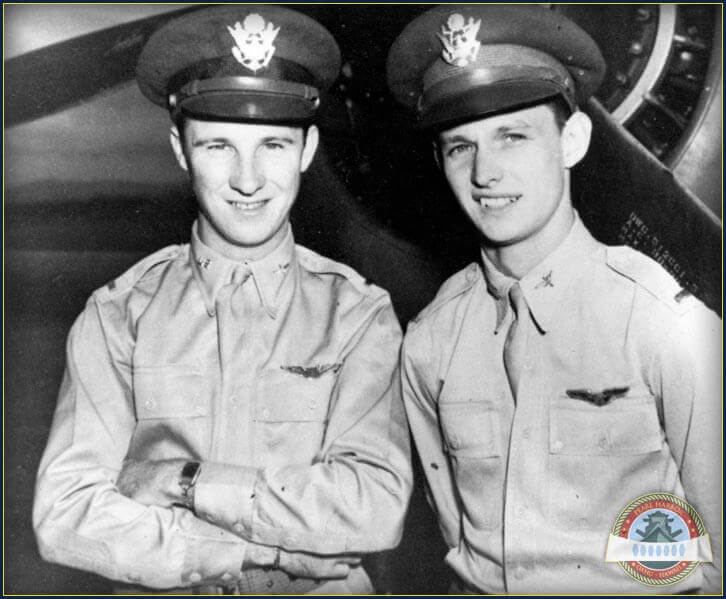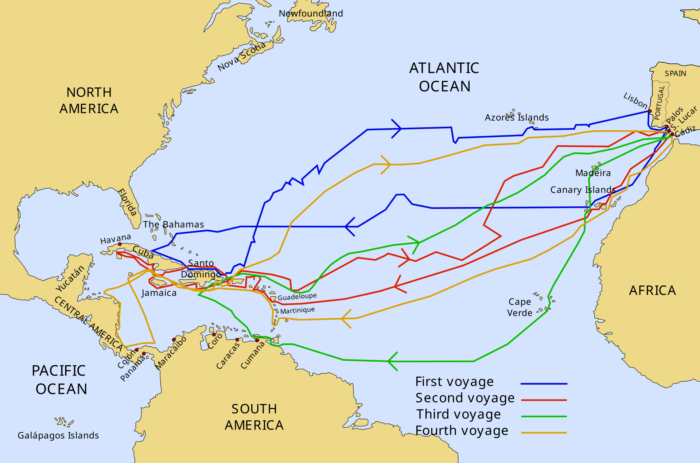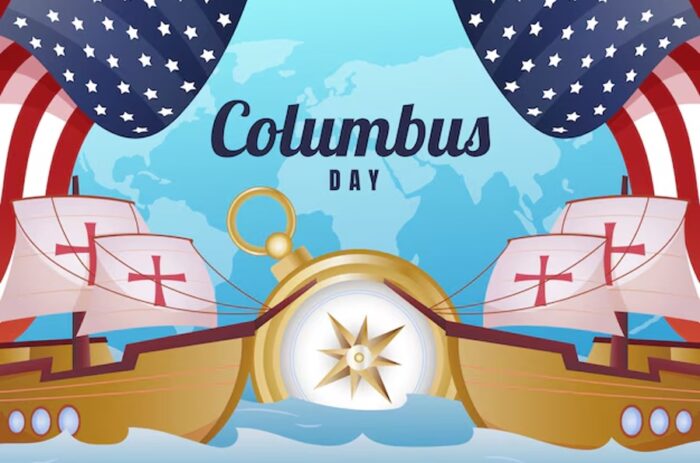
Army Air Corps pilots Kenneth Taylor and George Welch.
redo Jump to...
print Print...
Not enough of us today will think of those Americans who gave their lives in the jungles of the Pacific or in the skies above Europe, who fought in North Africa or on the beaches of Sicily and Normandy or wherever they were sent to defend not only their country but the cause of freedom around the world. Cut down before their time, they never grew old. Still young in their fresh soldier boy’s uniforms or coats of Navy blue, their pictures still stand somewhere almost lost among all the others atop crowded mantles and chifferobes across the country, their gazes fixed on us from the past. If we would only look. And learn. (from an editorial by Paul Greenberg)
1. Samuel Fuqua
Missouri-born Samuel Fuqua had a front row seat to the devastation at Pearl Harbor from aboard USS Arizona, a battleship that was heavily bombed during the first wave of the attack. The 42-year-old lieutenant commander was having breakfast when the ship’s air raid sirens first sounded around 7:55 a.m. He immediately rushed to the quarterdeck, only to be strafed by enemy fire and then knocked out cold when a bomb fell just feet away from him. Though dazed, Fuqua jumped to his feet after regaining consciousness and began directing firefighting operations. Moments later, he became the Arizona’s senior surviving officer after another bomb detonated the ship’s ammunition magazine, killing more than 1,000 men. As burned and maimed sailors poured onto the deck, Fuqua ignored gunfire from passing aircraft and calmly led efforts to evacuate his sinking ship.
“I can still see him standing there,” Arizona crewman Edward Wentzlaff later remembered, “ankle deep in water, stub of a cigar in his mouth, cool and efficient, oblivious to the danger about him.”
Fuqua was among the last men to abandon ship. He and two fellow officers then commandeered a boat and braved heavy fire while picking up survivors from the fire-streaked waters. He went on to win the Medal of Honor for his actions at Pearl Harbor, and was later promoted to rear admiral upon his retirement from the Navy in 1953.
2. Peter Tomich
Around the same time Arizona was being bombed, the training and target ship USS Utah was rocked by two torpedo strikes from Japanese aircraft. The aging vessel soon began to list to one side as water flooded into its hull. Inside the boiler room, Chief Watertender Peter Tomich ordered his crew to abandon ship.
After ensuring that his men had escaped their engineering spaces, the Austro-Hungarian immigrant and World War I veteran returned to his post and singlehandedly secured the boilers, preventing a potential explosion that would have claimed many lives. USS Utah rolled over and sank just minutes later. Fifty-eight men—Tomich among them—went down with the ship. The 48-year-old was posthumously awarded the Medal of Honor for his lifesaving actions, but in an unusual twist, the Navy was unable to locate any of his family members. His award went unclaimed for nearly 65 years until 2006, when it was finally presented to a relative during a ceremony in Split, Croatia.
3. George Welch and Kenneth Taylor
Army Air Corps pilots George Welch and Kenneth Taylor spent the evening before the Pearl Harbor attack attending a formal dance and playing poker until the wee hours of the morning. They were still sleeping off their night of partying when they were awakened around 8 a.m. by the sound of exploding bombs and machine gun fire. Not wanting to miss out on a fight, the pair threw on their tuxedo pants and sped to Haleiwa airfield in Taylor’s Buick, dodging strafing Japanese planes along the way. Just minutes later, they became the first American pilots to get airborne after they took off in their P-40 fighters.
Welch and Taylor went on to wage a lonely battle against hundreds of enemy planes. They even landed at Wheeler airfield at one point and had their ammunition replenished before rejoining the fray. By the time the attack ended, the second lieutenants had shot down at least six fighters and bombers between them. Both were awarded the Distinguished Service Cross for their high flying exploits, and Taylor was given a Purple Heart for a shrapnel wound he received when his P-40 was struck by machine gun fire.
4. Doris Miller
Doris Miller’s skin color usually relegated him to the role of cook and laundry attendant aboard USS West Virginia, but when the ship was struck by multiple bombs and torpedoes on December 7, he became one of its most vital crewmembers. Miller had rushed to his battle station amidships as soon as the shooting started. Finding it destroyed, the amateur boxer sprinted to the quarterdeck and used his hulking frame to help move the injured. Miller was among the men who carried the ship’s mortally wounded skipper to safety, and he then helped pass ammunition to the crews of two .50 caliber machine guns.
Despite having no weapons training, he eventually manned one of the weapons himself and began blasting away at the Japanese fighters swarming around the ship. “It wasn’t hard,” he later remembered. “I just pulled the trigger and she worked fine…I think I got one of those Jap planes. They were diving pretty close to us.”
Miller continued to operate the gun for some 15 minutes until ordered to abandon ship. His actions earned him the Navy Cross—the first ever presented to an African American—and he was widely hailed as a war hero in the black press. He later toured the country promoting war bonds before being reassigned to the escort carrier Liscome Bay. Sadly, Miller was among the 646 crewmen killed when the ship was torpedoed and sunk in 1943.
5. John Finn

Chief Petty Officer John Finn was still lying in bed with his wife when Japanese fighter planes descended on his post at the Kaneohe Bay air station some 15 miles from Pearl Harbor. After throwing on clothes and driving to the base, he commandeered a .30 caliber machine gun and dragged it to an open area with a clear view of the sky. For the next two-and-a-half hours, Finn kept up a near-constant rate of fire against the strafing hordes of Zeroes, and may have been responsible for destroying at least one plane.
“I can’t honestly say I hit any,” he remembered in 2001. “But I shot at every damn plane I could see.” Finn suffered more than 20 wounds from bullets and shrapnel during the battle. One shot left him with a broken foot; another completely incapacitated his left arm. He received medical aid after the attack ended, but returned to duty that same day to assist in arming American planes. Finn’s machine gun heroics won him the Medal of Honor—the only one awarded specifically for a combat action during Pearl Harbor. He would go on to survive the war and live to the age of 100.
6. George Walters
One of the many civilians to win plaudits during the Pearl Harbor attack, George Walters was a dockyard worker who manned a massive rolling crane positioned alongside the dry-docked battleship USS Pennsylvania. When the yard came under fire during the early stages of the raid, he valiantly moved his crane back and forth on its track, effectively shielding Pennsylvania from low flying dive-bombers and fighters. Walters even tried to use the crane’s boom to swat the enemy planes out of the sky.
The gunners on Pennsylvania initially considered the dockworker a nuisance, but they soon realized that his 50-foot-high cab gave him an excellent view of incoming aircraft. Using the movements of the crane arm as a guide, they were able to return fire against the enemy to devastating effect. Walters continued his suicidal maneuvers until a Japanese bomb exploded on the dock and sent him to the hospital with a concussion. His actions may have helped save Pennsylvania from destruction, but his story went largely untold until 1957, when it appeared in author Walter Lord’s famous book Day of Infamy.
7. Edwin Hill
USS Nevada was the only ship from Pearl Harbor’s Battleship Row to make a break for the open ocean, but its great escape might never have happened if not for the efforts of 47-year-old Chief Boatswain Edwin Hill. Shortly after the battle began, Hill and a small crew braved heavy fire and strafing to go ashore and cut the moorings holding the Nevada to the quay at Ford Island. He then dove into the oil-stained water and swam back to his ship to continue the fight. As Hill directed an ammunition train, Nevada ran a gauntlet of enemy fire and tried to steam out of the harbor. The lone battleship was an obvious target, however, and after taking repeated hits from Japanese dive-bombers, its captain opted to beach his vessel to avoid bottling up the rest of the fleet.
Chief Hill was soon called into action a final time. He was on the forecastle working to drop anchor when a group Japanese planes rained bombs on the deck, blowing his body off the ship and killing him instantly. Hill was later posthumously awarded the Medal of Honor. USS Nevada, meanwhile, survived Pearl Harbor and went on to participate in the Normandy invasion in 1944.
8. Phil Rasmussen
Phil Rasmussen was one of the handful of American pilots who managed to take to the skies during the attack on Pearl Harbor. Like many others, the 23-year-old second lieutenant was still sleeping when his post at Wheeler Field was bombed, but he rushed outside and found an undamaged P-36 fighter sitting on the runway. Still clad in a pair of purple pajamas, Rasmussen took off and joined three other pilots in a dogfight against 11 Japanese aircraft. His plane was slower and less maneuverable than the enemy Zeroes, but he quickly managed to shoot one of them down. He then crippled another plane before two Japanese pilots raked his P-36 with machine gun and cannon fire, leaving behind some 500 bullet holes. Another Zero just narrowly missed when it tried to ram him. Rasmussen’s canopy was blown off and he briefly lost control, but he managed to right his damaged plane and make a miraculous landing without brakes, rudders or a tail wheel. The young pilot was awarded a Silver Star for his bravery, and went on to serve in the Air Force for another 24 years before retiring as a colonel.
The stories above are by Evan Andrews, History .com, Dec. 3, 2019. Reprinted here on December 5, 2019, for educational purposes only. May not be reproduced on other websites without permission from History .com.
Questions
Read more about these heroes at pearlharbor.org.
1. The purpose of an editorial/commentary is to explain, persuade, warn, criticize, exhort, entertain, praise or answer. What do you think is the purpose of Evan Andrews’ editorial? Explain your answer.
2. Tone is the attitude a writer takes towards his subject: the tone can be serious, humorous, sarcastic, ironic, inspiring, solemn, objective, cynical, optimistic, critical, enthusiastic…etc.
Which word do you think best describes the tone of the commentary? Explain your answer.
CHALLENGE: Listen to President Franklin D. Roosevelt’s entire Dec. 8, 1941 “Infamy” speech to Congress (see video under “Resources” below). What surprises you about the President’s speech? About Congress’ reaction?
Background
THE ATTACK ON PEARL HARBOR The attack on Pearl Harbor was a surprise military strike conducted by the Imperial Japanese Navy against the United States naval base at Pearl Harbor, Hawaii on the morning of December 7, 1941.
- The base was attacked by 353 Japanese aircraft in two waves, launched from six aircraft carriers.
- Four U.S. Navy battleships were sunk (two of which were raised and returned to service later in the war) and the four other battleships present were damaged.
- The Japanese also sank or damaged three cruisers, three destroyers, an anti-aircraft training ship and one minelayer.
- 188 U.S. aircraft were destroyed, 2,402 personnel were killed and 1,282 were wounded.
- Nearly half of those who perished were sailors aboard the battleship USS Arizona, which Japanese torpedo bombers sank early in the attack, sending 1,177 of its 1,400-member crew to their deaths.
- The USS Arizona Memorial, built over the remains of the ship, now forms a centerpiece of the World War II Valor in the Pacific National Monument, an historic site administered by the National Park Service. Visit the National Parks Service website for the USS Arizona Memorial at nps.gov.
- The power station, shipyard, maintenance, and fuel and torpedo storage facilities, as well as the submarine piers and headquarters building (also home of the intelligence section) were not attacked.
- Japanese losses were light, with 29 aircraft and five midget submarines lost, and 65 servicemen killed or wounded. One Japanese sailor was captured.
- The following day [Dec. 8] the United States declared war on Japan.
- Subsequent operations by the U.S., as well as the Axis alliance, prompted Germany and Italy to declare war on the U.S. on December 11, which was reciprocated by the U.S. the same day.
- Despite numerous historical precedents for unannounced military action, the lack of any formal warning by Japan, particularly while negotiations were still apparently ongoing, led to President Franklin D. Roosevelt proclaiming December 7, 1941, “a date which will live in infamy.” (excerpted in part from wikipedia)
Resources
In a speech Dec. 8, 1941 asking Congress to declare war on Japan after the bombing of Pearl Harbor, President Franklin D. Rooselvelt said in part:
“Yesterday, December 7, 1941 – a date which will live in infamy – the United States of America was suddenly and deliberately attacked by naval and air forces of the Empire of Japan… No matter how long it may take us to overcome this premeditated invasion, the American people will through their righteous might win through to absolute victory… With confidence in our armed forces – with the unbounded determination of our people – we will gain the inevitable triumph – so help us God. I, therefore, ask that the Congress declare that since the dastardly and unprovoked attack by Japan on Sunday, December 7th, a state of war has existed between the United States and the Japanese Empire.”
— Listen to President Roosevelt below:
- Read FDR’s speech to Congress at docs.fdrlibrary.marist.edu, OR
- Listen to FDR’s speech to Congress at history.com
For photos of Pearl Harbor and the attack, go to the U.S. Navy’s history website at history.navy.mil.
Watch a video on the Pearl Harbor attack below:
Read a December 2016 news report: “Oldest Pearl Harbor Survivor, 104, Flies Back to Honolulu”









